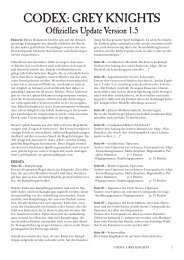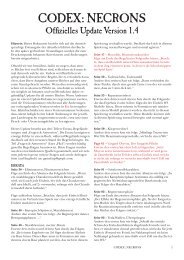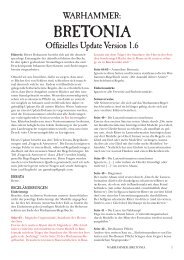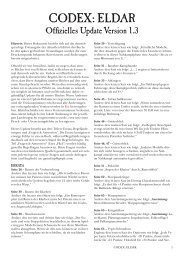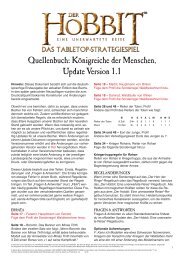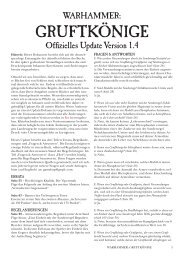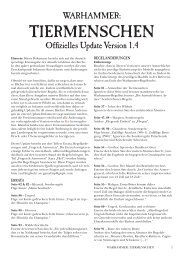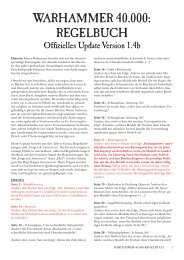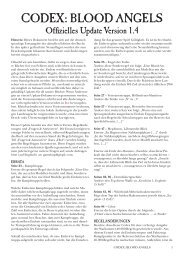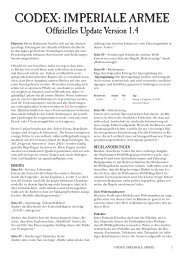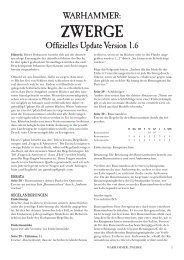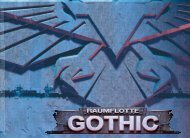Necromunda rulebook - Games Workshop
Necromunda rulebook - Games Workshop
Necromunda rulebook - Games Workshop
You also want an ePaper? Increase the reach of your titles
YUMPU automatically turns print PDFs into web optimized ePapers that Google loves.
MODELS<br />
<strong>Games</strong> of <strong>Necromunda</strong> are fought out using<br />
model fighters, each approximately 28mm tall.<br />
Before playing you need enough models to<br />
assemble a complete ‘gang’ as detailed later in<br />
the rules. A large variety of different models are<br />
available from <strong>Games</strong> <strong>Workshop</strong>, illustrations of<br />
which can be found throughout this book, and<br />
particular in the colour section at its centre.<br />
TEMPLATES<br />
Special templates are used to determine the effects of<br />
many weapons. For example, grenade and shell<br />
bursts, and the gout of burning fire projected by a<br />
flamer. You can find these near the back of the book,<br />
on page 142. You can photocopy this page and cut<br />
out the templates for use in your games, or<br />
alternatively purchase more sturdy plastic versions<br />
available from <strong>Games</strong> <strong>Workshop</strong>.<br />
DICE<br />
A variety of different dice are used in the<br />
<strong>Necromunda</strong> game, as follows.<br />
From left to right: Two D6’s, a scatter dice, and an<br />
artillery dice<br />
Ordinary dice (known as D6’s) are marked 1 to 6<br />
in the usual way. These dice are used a lot during play<br />
and to save space on charts they are always referred<br />
to as D6 (where ‘D’ stands for dice). So, when the<br />
rules call upon you to roll a D6 we are simply asking<br />
you to roll a dice. D6+1 means roll a dice and add 1<br />
to the score. 2D6 means roll two dice and add the<br />
scores together to obtain a score of 2-12.<br />
The Scatter dice is marked with four arrows and<br />
two HIT symbols. This dice is used to determine<br />
where grenades and shells land if they miss their<br />
target, hence ‘scatter’. The dice can be used to<br />
establish any random direction from a point. Note<br />
that the HIT symbol also has a small arrow on it to<br />
facilitate this.<br />
The Artillery dice is marked 2, 4, 6, 8, 10 and<br />
MISFIRE. This dice is used in conjunction with the<br />
Scatter dice to determine how far shells land from<br />
their mark. A MISFIRE result can result in a shell<br />
proving dud or even exploding in the breach.<br />
In some cases, you will also find references to a dice<br />
called a D3. There isn’t actually any such thing as a 3sided<br />
dice, instead a D3 means roll a D6 and halve<br />
the result rounding up.<br />
So, for a D3, a roll of a 1 or 2 = 1, a roll of 3 or 4 =<br />
2 and a roll of 5 or 6 = 3.<br />
WHAT YOU WILL NEED<br />
5<br />
NECROMUNDA<br />
WHAT ELSE YOU WILL NEED<br />
In addition to the game components mentioned<br />
above you will need two or more players and a firm,<br />
level tabletop or area of floor. A kitchen table will do<br />
fine. Some gamers make their own gaming tables<br />
from a sheet of chipboard or something similar. Such<br />
a table can be slightly larger than the table or trestles<br />
that support it, and can be divided into two or more<br />
pieces for ease of storage. Many players find that a<br />
heavy blanket draped over a table or spread upon the<br />
floor makes a fine surface on which to play a battle.<br />
You will need at least one retractable tape measure<br />
marked in feet and inches. All distances in<br />
<strong>Necromunda</strong> are given in Imperial units.<br />
Pens and pencils, and plenty of paper will also be<br />
required. When you play a game you will need to<br />
keep track of wounds suffered by your fighters, the<br />
weapons they are carrying, and other details. This is<br />
most easily done using a roster sheet, an example of<br />
which is included in this book. We recommend that<br />
you copy or photocopy additional roster sheets and<br />
use them to record details during the game. We’ll<br />
explain more about roster sheets and how to use<br />
them later in this book.



